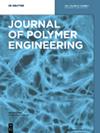Influence of betalain natural dye from red beet in gum acacia biopolymer: optical and electrical perspective
IF 1.7
4区 工程技术
Q4 POLYMER SCIENCE
引用次数: 0
Abstract
Abstract In this study, the development and characterization of a plant-derived biopolymer, gum acacia, chemically modified by an herbal dye, red beetroot (Latin Beta vulgaris ) has been presented. Red beetroot, a flowering plant with abundant phytochemicals, prevents diseases and produces colorful chromophores. Chromophores interact with incident intense electromagnetic field and thereby absorb radiation in ultraviolet and/or visible region of the spectrum, promoting low to high-level electron excitation between different energy states. Such transition influences variation in optical and electrical properties of the system. Optical properties of both biopolymer unmodified gum acacia specimen and after modification with red beet induced chromophore are investigated by UV–visible absorption spectroscopy. Pronounced light absorption is observed in the visible range of the spectrum compared to the unmodified specimen in which absorption is found to be observed in the deep ultraviolet range. Electrical characterization of the modified biopolymer with red beetroot extract suggests eviation from ideal dielectric relaxation obeying Debye mechanism. Electrical conductivity is found to be enhanced over pure specimen. These properties are eligible for application in energy storage devices, especially as a sensitizer in photovoltaic material which are ongoing extensive research area.红甜菜甜菜素天然染料对阿拉伯胶生物聚合物的影响:光学和电学角度
摘要:本研究介绍了一种植物源性生物聚合物——阿拉伯胶的开发和表征,该聚合物由草药染料红甜菜根(拉丁Beta vulgaris)进行化学修饰。红甜菜根是一种开花植物,含有丰富的植物化学物质,具有预防疾病和产生彩色发色团的作用。发色团与入射的强电磁场相互作用,从而吸收光谱中紫外线和/或可见光区域的辐射,促进不同能态之间的低到高电子激发。这种转变影响了系统的光学和电学性质的变化。采用紫外-可见吸收光谱法研究了未改性的生物聚合物和红甜菜诱导发色团改性后的金合欢胶样品的光学性质。在光谱的可见范围内观察到明显的光吸收,与未修饰的样品相比,在深紫外范围内观察到吸收。用红甜菜根提取物修饰的生物聚合物的电学特性表明其偏离了理想的介电弛豫,服从德拜机制。电导率比纯样品高。这些特性适合应用于储能器件,特别是光伏材料的敏化剂,是目前广泛研究的领域。
本文章由计算机程序翻译,如有差异,请以英文原文为准。
求助全文
约1分钟内获得全文
求助全文
来源期刊

Journal of Polymer Engineering
工程技术-高分子科学
CiteScore
3.20
自引率
5.00%
发文量
95
审稿时长
2.5 months
期刊介绍:
Journal of Polymer Engineering publishes reviews, original basic and applied research contributions as well as recent technological developments in polymer engineering. Polymer engineering is a strongly interdisciplinary field and papers published by the journal may span areas such as polymer physics, polymer processing and engineering of polymer-based materials and their applications. The editors and the publisher are committed to high quality standards and rapid handling of the peer review and publication processes.
 求助内容:
求助内容: 应助结果提醒方式:
应助结果提醒方式:


